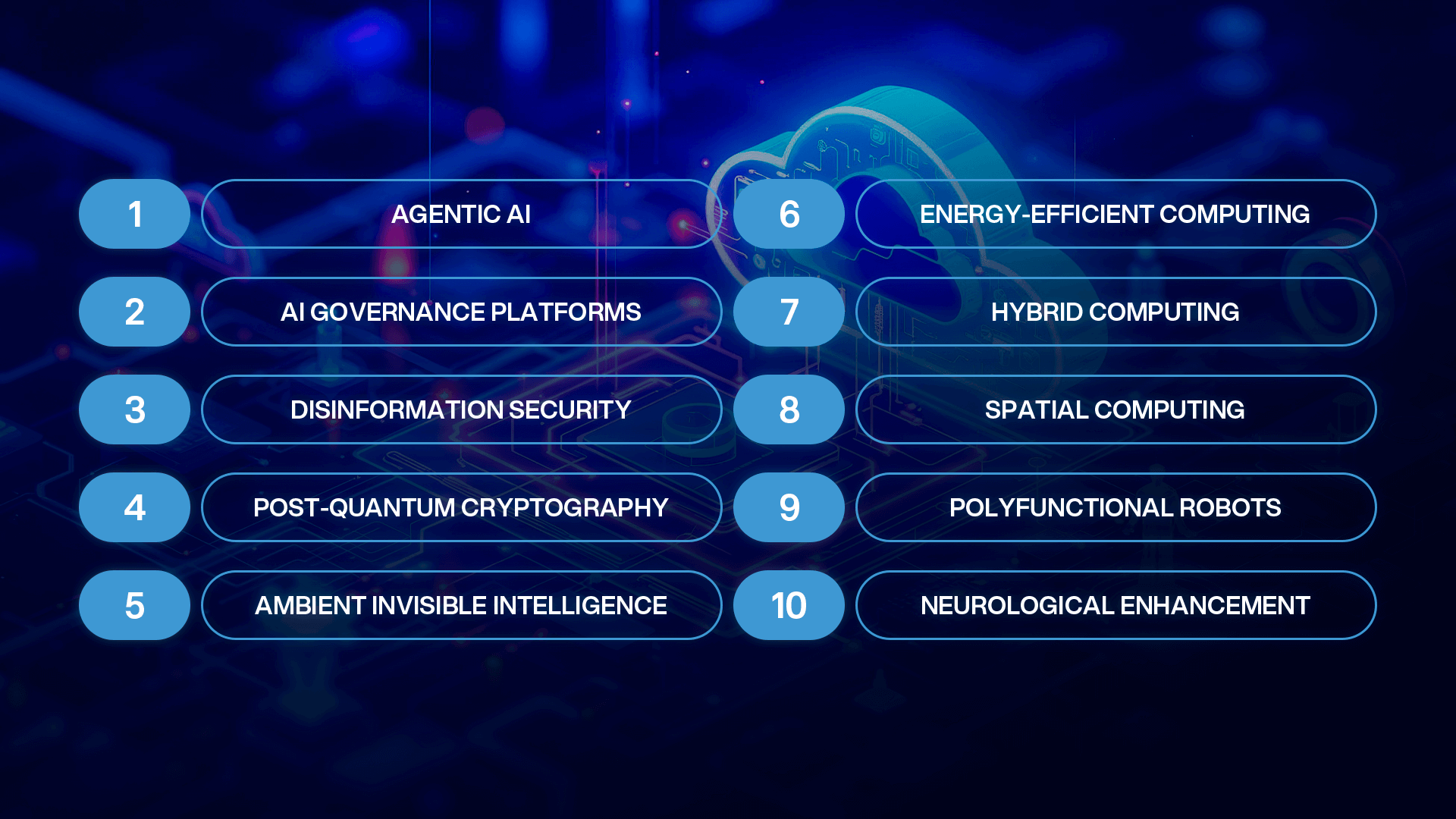Gartner Tech Trends for 2025: 10 innovations to drive business growth
10 de December de 2024

10 de December de 2024

As we move closer to 2025, technology is advancing at a pace that requires businesses to reassess their strategies for digital transformation. The next few years will bring significant operational changes and opportunities to lead in innovation, security, and sustainability. According to Gartner’s latest report, the following 10 tech trends are poised to impact industries in profound ways. These trends provide essential insights for business leaders seeking to stay competitive and agile in an increasingly complex technological environment.

Artificial intelligence is advancing beyond simple automation, with systems now capable of making autonomous decisions to achieve specific goals. Agentic AI systems will help businesses operate more efficiently by reducing the need for human intervention in routine decision-making. For example, companies like Tesla have been integrating autonomous AI in their vehicles, allowing for safer and more efficient driving experiences. Similarly, autonomous robots and AI can detect inefficiencies in manufacturing and optimize production without human input. AI’s growing market, which is projected to reach nearly $1 trillion by 2027, reflects this shift. Companies should leverage agentic AI to optimize their workflows and reduce costs while scaling their operations.
As AI systems become more integrated into business processes, the need for governance has never been more urgent. AI governance platforms will ensure that AI applications are managed responsibly, focusing on transparency, accountability, and ethical considerations. For instance, Microsoft has implemented AI ethics boards and governance frameworks to ensure that their AI systems are developed and deployed responsibly. These platforms will allow businesses to maintain control over AI’s impact, ensuring its responsible deployment and fostering trust among stakeholders.
As businesses increasingly rely on digital channels and data-driven decisions, ensuring the accuracy and integrity of information has become a strategic priority. Disinformation security technologies will help detect and combat the spread of false or misleading information, protecting brands and ensuring data-driven decisions are based on reliable sources. Companies like Twitter and Facebook are already integrating AI-driven tools to combat fake news, recognizing its detrimental effects on brand credibility and customer trust. For leadership, this is an opportunity to enhance brand trust and maintain operational integrity, especially in sectors like finance, healthcare, and media, where the accuracy of information directly affects outcomes.
Quantum computing poses a major threat to current encryption methods, potentially compromising sensitive data. Post-quantum cryptography (PQC) is designed to provide encryption methods that will resist the power of quantum machines. As quantum computing continues to advance, businesses need to prepare for this inevitable shift by adopting PQC technologies. Companies like Google and IBM are already researching and investing in quantum-resistant cryptography to secure their data against the eventual arrival of quantum computing. Early adoption of PQC will help organizations secure intellectual property and sensitive information against upcoming threats.
Ambient invisible intelligence refers to integrating low-cost sensors and intelligent systems into everyday environments to collect and analyze data seamlessly. This allows businesses to create smarter, more responsive environments that can optimize operations in real-time. For example, Amazon Go stores use ambient intelligence through sensors and cameras to automatically track customer purchases and eliminate the need for traditional checkout. In industries like retail and logistics, ambient intelligence can enhance customer experiences, improve supply chain visibility, and reduce operational costs. By leveraging this technology, businesses can create environments that adapt in real-time to changing demands and conditions.
With increasing focus on sustainability, energy-efficient computing will play a crucial role in reducing the environmental impact of technology. Data centers, cloud computing, and AI models are becoming more energy-intensive, and optimizing energy use is becoming a priority for businesses looking to reduce both their operational costs and carbon footprint. Companies like Google are leading the way in energy-efficient computing by investing in renewable energy sources to power their data centers, thus significantly reducing their carbon emissions. By adopting energy-efficient systems, businesses not only meet regulatory requirements but also strengthen their corporate reputation as environmentally responsible organizations.
Hybrid computing integrates on-premise, private cloud, and public cloud resources to deliver more flexible, scalable solutions for complex problems. This approach allows businesses to optimize resource allocation, handling sensitive data internally while utilizing the cloud for compute-intensive tasks. Microsoft Azure and Amazon Web Services (AWS) are prime examples of cloud platforms that support hybrid environments, enabling businesses to tailor their computing infrastructure to meet specific needs. Hybrid computing will be key to enhancing agility, enabling businesses to scale quickly while maintaining control over data security. Companies adopting hybrid computing strategies will be better equipped to handle the increasing complexity of business demands.
Spatial computing is redefining how businesses interact with digital information. Technologies like augmented reality (AR), virtual reality (VR), and the Internet of Things (IoT) enable businesses to create immersive, interactive experiences that blend the digital and physical worlds. IKEA uses AR technology in their app, letting customers virtually place furniture in their homes before buying to enhance the shopping experience. For industries such as retail, education, and healthcare, spatial computing will create entirely new ways to engage customers and improve operational efficiency. Embracing these technologies will enable businesses to build new business models and enhance how they engage with customers and employees.
Polyfunctional robots can perform a wide variety of tasks autonomously, offering businesses unparalleled flexibility and efficiency. Unlike single-function robots, these systems can be repurposed for different roles, from manufacturing to customer service. For example, the Boston Dynamics’ Spot robot is capable of inspecting facilities, monitoring equipment, and performing autonomous tasks in different environments. The ability to adapt these robots quickly to new tasks will help businesses scale automation without increasing reliance on specialized machinery. Polyfunctional robots will streamline operations, reduce labor costs, and improve service quality across industries.
Neurological enhancement involves technologies that improve cognitive abilities by decoding brain activity. These advancements will allow businesses to unlock new levels of human productivity by enhancing decision-making, creativity, and overall performance. Companies like Neurable are already developing brain-computer interfaces that allow users to control devices using only their thoughts. As these technologies evolve, businesses will find new ways to enhance employee performance, reduce cognitive overload, and solve complex problems faster. The potential for neurological enhancement in the workplace could transform how work is performed, driving innovation and improving team performance.
As the business world prepares for the technologies of 2025, organizations must begin integrating these innovations into their long-term strategies. From Agentic AI and post-quantum cryptography to spatial computing and polyfunctional robots, these trends represent both opportunities and challenges that can redefine the way businesses operate. Early adoption of these technologies will help businesses stay competitive, secure, and efficient, positioning them for success in an increasingly tech-driven world. By strategically aligning digital transformation efforts with these emerging technologies, businesses can ensure resilience, growth, and innovation in the years ahead.
As we approach 2025, embracing Gartner’s tech trends is essential to stay competitive and drive innovation. At Luby, we specialize in helping businesses integrate these emerging technologies into their digital transformation strategies. Ready to lead the charge and future-proof your organization? Contact us today and let’s explore how Luby can guide your business through the next wave of technological advancements.